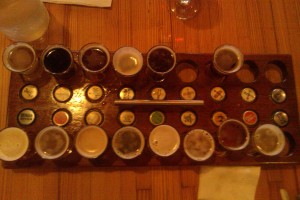The wine market is crowded. There are thousands of wineries jumping up and down screaming, ‘ME, ME, ME!!!’, all trying to tell a story about what makes them different. It’s a story that wine buyers and potential customers are getting bored of.
It is not the top tier of producers we are talking about – those making truly fine wine. While fine wine has problems of its own, there will always be demand for the best of the best, whatever the price. Neither is it the industrial wine producers, for whom style trumps substance, who use cold hard cash to open the right doors and who, largely, cater to the lowest-common-denominator drinker.
The producers I am talking about cover the middle ground – independent, small- to medium-sized producers making good everyday wine.
Who are they competing with for shelf space, for by the glass listings, for column inches? Not fine wine, and not corporate industrial wineries – they’ve already bought that shelf space, those listings and that media attention. In truth they are competing with their neighbors – other independent producers.
Now, take a look at the beer market according to The Brewers Association. Overall beer sales by volume are decreasing every year, yet the market for craft beer is stronger than ever. It has grown by figures between 7 and 12 percent for the past couple of years. To put it simply, craft beer is making huge gains in a sector that is contracting.
How are craft beer producers doing this? The answer is simple – they have mobilized their consumers around a set of shared principles to advocate on their behalf – not only to drink craft beer, but to demand it at restaurants, bars and liquor stores and to force it into the hands of family and friends.
To get an idea of this, watch this video. If only wine lovers were that passionate and driven! Those are real consumers and, even more powerfully, front line sales people. And how have craft brewers achieved this?
Innovation, collaboration and risk taking.
To Greg Koch, CEO and co-founder of Stone Brewing in San Diego, wineries have to be genuinely innovative, if they are to succeed in the same manner that craft breweries have. He states that for wineries who want to embrace a craft beer ethos of innovation, style and collaboration, the trick “is to actually do those sort of things!” He believes that the success of the craft brewing industry is due to the fact the “the true differentiation was in the beer itself.” He poses the question: “What does true innovation look like in the wine world?”
Koch encourages small wineries to look at their larger competitors for cues about “what not to do”, particularly when it comes to sales and marketing. He also points out that, from the get go, craft brewers wanted to be authentic – which to him means being authentic in every part of your business practice, not just your product.
Come together
More than any industry today, the craft brewing industry is one that celebrates collaboration – that recognizes that a win for one craft brewer is a win for entire industry. This collaboration is taken to its logical conclusion – it is now the norm for craft beer brewers to get together and brew one-off collaborative brews – exchanging ideas, techniques and skills for the betterment of all involved.
While this does happen in the wine industry, it is the exception and not the rule, and it tends to be concentrated at the very top tier – you all know the names. This is despite the fact that collaboration happens every day in the wine industry – winery one sells grapes to winery two, for example – and no one seems very keen to be public with it.
The consumer is smart enough to understand that the reason winery one sells grapes to winery two is not that the fruit isn’t very good, but rather that it just isn’t suited to making the type of wine winery one wants to make or that the vineyard produces more wine than winery two can sell.
Why can’t those two (or more) wineries use their collective marketing power to sell wine for both or all of the producers involved? One great example of this from my neck of the woods is the 2010 Riesling Challenge. The idea is simple – give 12 fantastic winemakers the same fruit and then see what they come up with. The wines are released in packs of 12, one from each winemaker. This forces a winery’s customers to try other like-minded producers’ wines – but it also means that those 11 other sets of consumers may be trying wine from an unknown or off-the-radar producer. Beyond that, the media spin-off from a collaboration also raises the profile of the producers, as well as exposing others to the message they are trying to communicate in a exciting, fun way.
Collaboration also happens on an international scale. It is pretty normal for winemakers from different regions to visit others and work in other wineries over harvest time. Why not make collaborative wines – small scale, one off wines that push the boundaries as craft beer collaborations do – with all parties taking a share to sell in their respective cellar doors and on their mailing lists? For Mikkel Borg Bjergsø, the Danish ‘Gyspsy Brewer’ who brews beers for his brand Mikkeller at different craft breweries in Europe as well as in the UK and USA, international collaboration brews were important in gaining name recognition in new markets, thanks to the prestige of working with a well-known and respected local brewer.
The craft beer industry is also one that takes risks. Luke Nicholas, owner of Epic, a New Zealand craft brewer who specializes in hoppy pale ales and lagers puts it quite simply: “Try new things. It’s great, following tradition and making wine that everyone else is making, but why do that when someone or many others are already doing it? Do something unique, own that space.”
He also acknowledges that there are other challenges for wineries – that beers can be brewed several times a year, ingredients for making a unique product sourced from anywhere in the world, while turnaround is generally a lot quicker. However, wineries also have advantages, he points out: “the special thing wineries have going for them is the geographic location and the wine maker as a personality.”
That connection to a place, as well as to the people who make the product is becoming increasingly important, not just for wine lovers, but for average eaters and drinkers as well. For the craft beer industry, it means social and corporate responsibility with a special emphasis on having a craft brewery being a positive force in the community. As Greg Koch states: “I think that if you want to be important in the community, you have to be important to the community” and more than that, it has to be “a natural part of who you are as an entity.”
The biggest risks the craft beer industry took have paid off, big time. Craft brewers chose to collectively define themselves against the status quo of mainstream industrial brewers’ “fizzy yellow beer” that still represents the majority of the beer market. In doing so, they created the market for craft beer. To seize this opportunity, wineries have to be prepared to do the same – collectively differentiating themselves against mass-produced industrial wine, but also teaching the consumer what they do stand for – in many ways, the same principles as the craft breweries.
How those principles are to be interpreted is up to the collective of producers who embrace them. Obviously this may entail some commercial risk. But isn’t doing nothing even riskier?
Jules van Cruysen is a Sommelier turned Wine Rep based in Wellington, New Zealand he writes professionally for a number of New Zealand and International publications—you can follow him on twitter @grapengrain and read his blogs at grapengrain.co.nz and nzwinedispatch.blogspot.co.nz

